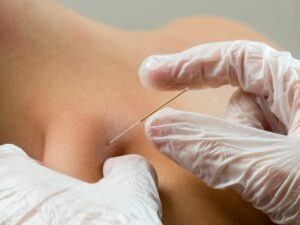Dry Needling and Physiotherapy
When I first started needling in 2006 most of my patients had never tried it before, or for some of them, had never even heard of this treatment technique. Today, most people have tried or at least heard of needling as part of treatment, but they do not always understand how it works. The most common question I receive regarding needling is, what makes it effective?
The most simple explanation is that a fine needle (same needles as used in acupuncture) is inserted into the motor unit of the muscle through the skin to get a twitch response. After maximal contraction (or the twitch) you get maximal relaxation and can reset the tight band of muscle. This technique is also called dry needling. This refers to the fact that nothing is being introduced through the needle, versus wet needling, where a larger needle is used to introduce substances into the muscle or tissue.
For those who are interested in understanding a little bit more about what happens and what effects introducing electrostim to the needle can have, let’s continue to break this down further.

Due to a change in the chemical regulation at the motor endplates of the muscle fibres, a taut band is formed in the muscle and we call this the trigger point. These bands can be formed from actual or potential tissue damage and are thought to be due to unaccustomed loads, repetitive strain, or prolonged postural loads on the tissue. In contractile tissue, there are both active and latent trigger points that can be responsible for altered muscle activation patterns, reduced range of motion and autonomic effects causing pain from the trigger point. This pain can be experienced locally at the trigger point itself as well as elsewhere in the body, which is known as referred pain. Each muscle has a pattern of referred pain. We experience pain from the trigger points due to lack of blood flow and lack of oxygen to the area causing a change in the pH balance.
The trigger point also affects central sensitization, with its connection to the dorsal horn of the spinal cord. We do not completely understand this process, but know that messages are sent to the dorsal horn of the spinal cord and that an inflammatory response is set into motion. This is linked to chronic pain and the process of the nervous system being in a persistent state of high reactivity and continued messages sent to the dorsal horn.
What this all means is that the process of creating this twitch release with the insertion of a needle into these taut bands, can have an effect both locally as well as centrally.
So what is this twitch response and what exactly happens when it occurs? This twitch response is an involuntary reflex contraction of the tight band of muscle from the spinal cord. This contraction changes the chemical environment of the muscle, and since we know the decreased pH of the muscle contributes to the painful stimuli, this twitch reflex will help with the pain. The needles itself can help with muscle regeneration as the microtrauma from the needle can help with tissue remodelling, as well this twitch response can help to reset the muscles to its original length assisting in restoring strength and range of motion.
So why would we add electrostim to this process? Electrostim can be beneficial for the needling process for many reasons, one is to create this twitch response, you often have to piston or move the needle and this process can be painful. By using electrostim through the needle, you can create this twitch without having to move the needle and this generally makes the treatment process less painful. At the same time as creating the twitch, you can also get the benefits of the electricity. In the same way that TENS can help block the pain response to the brain, the needle electrostim can as well. The use of elecrostim also allows us to needle more vulnerable muscles where pistoning the needle would not be indicated.
If needling is a treatment technique you would be interested in trying, be sure to talk to your practitioner to see if needling would be right for you.
